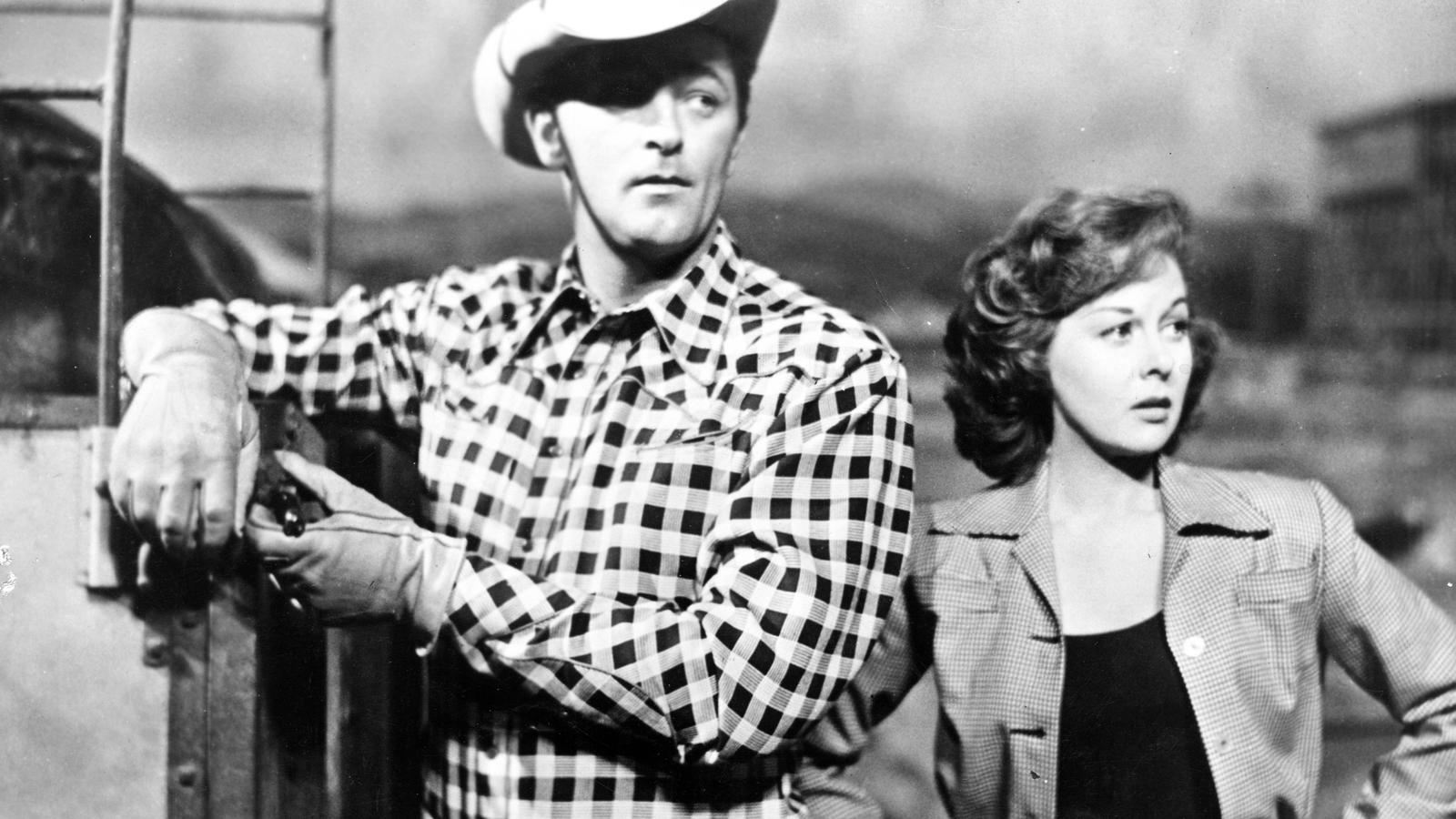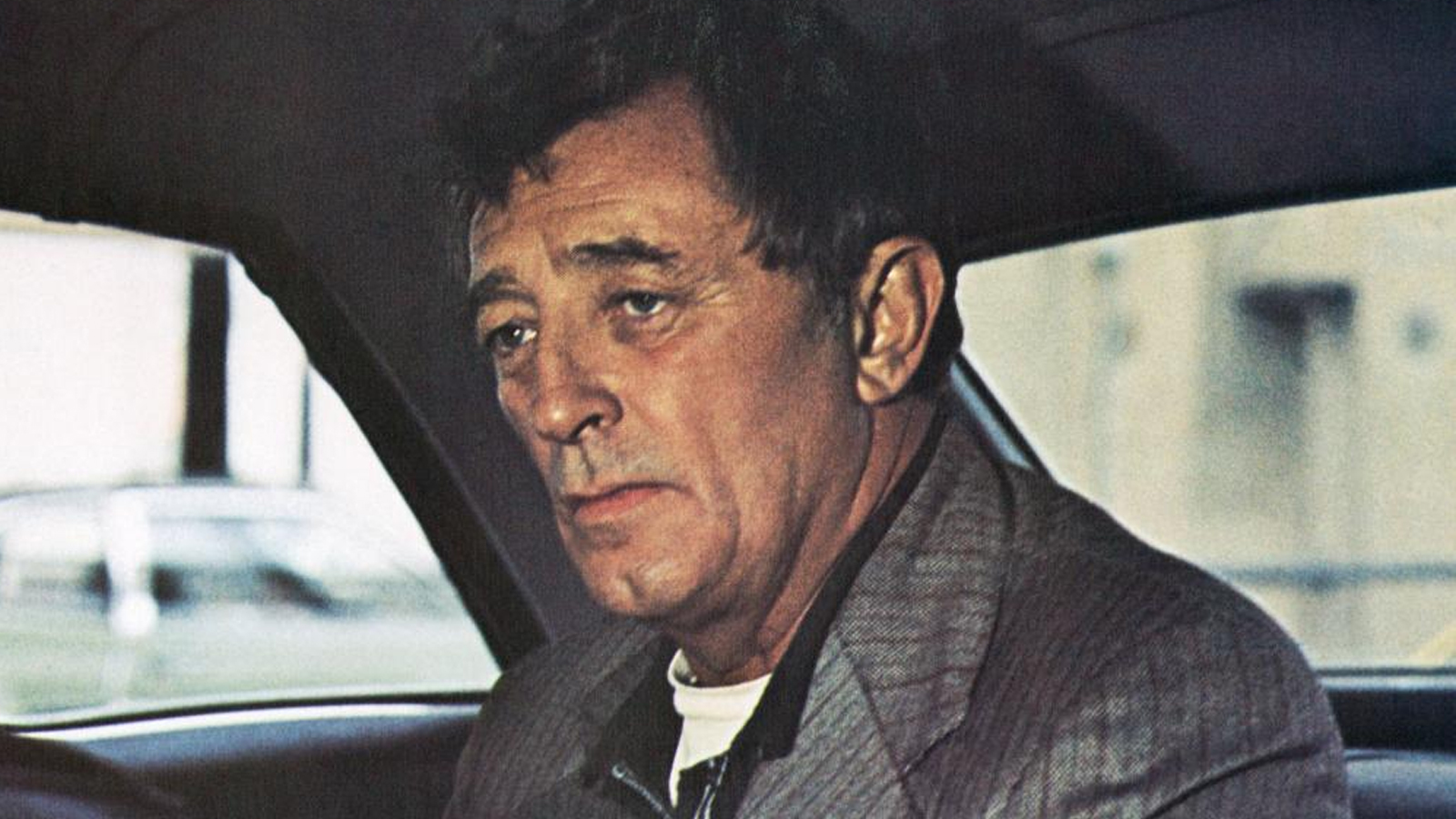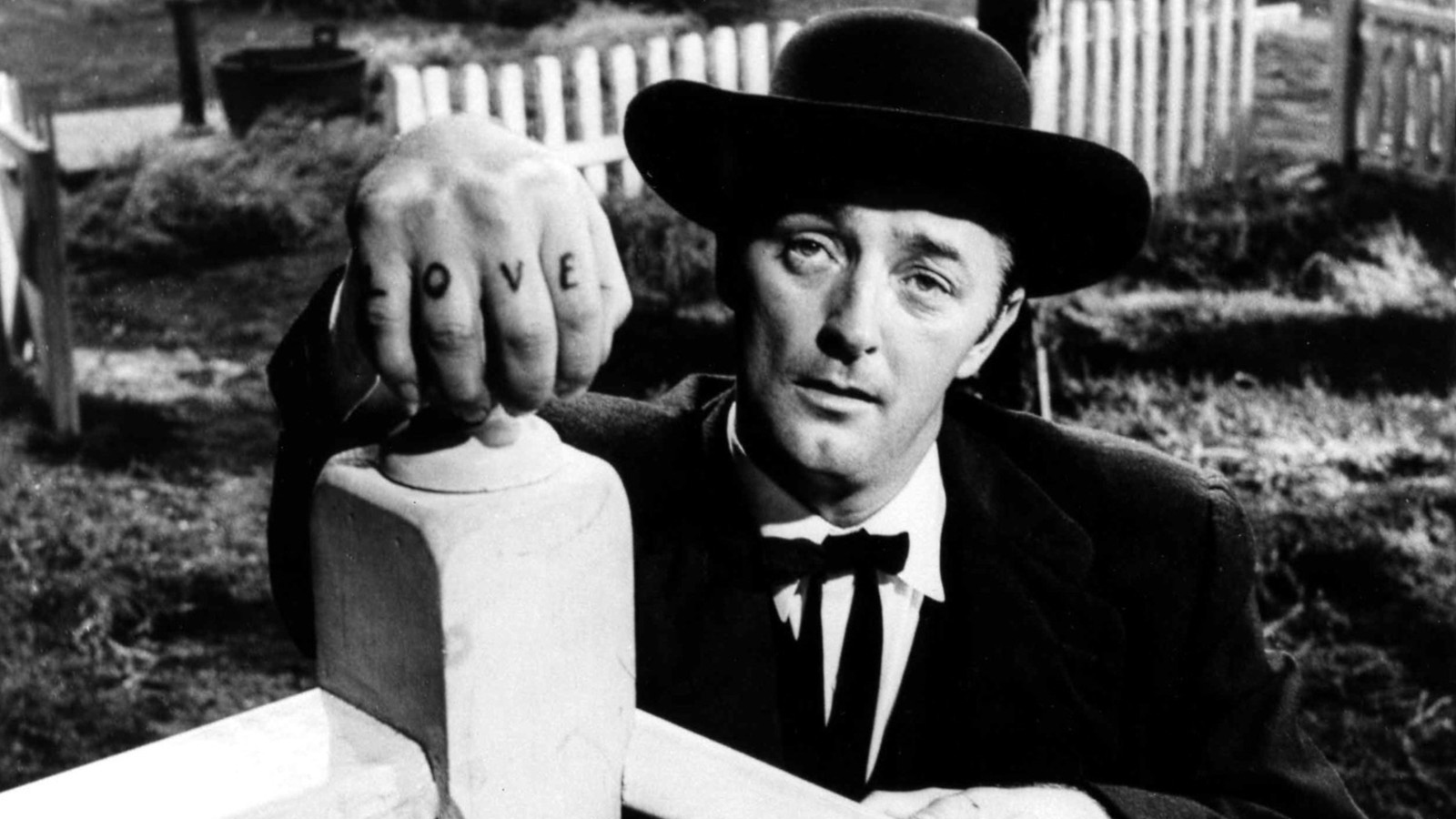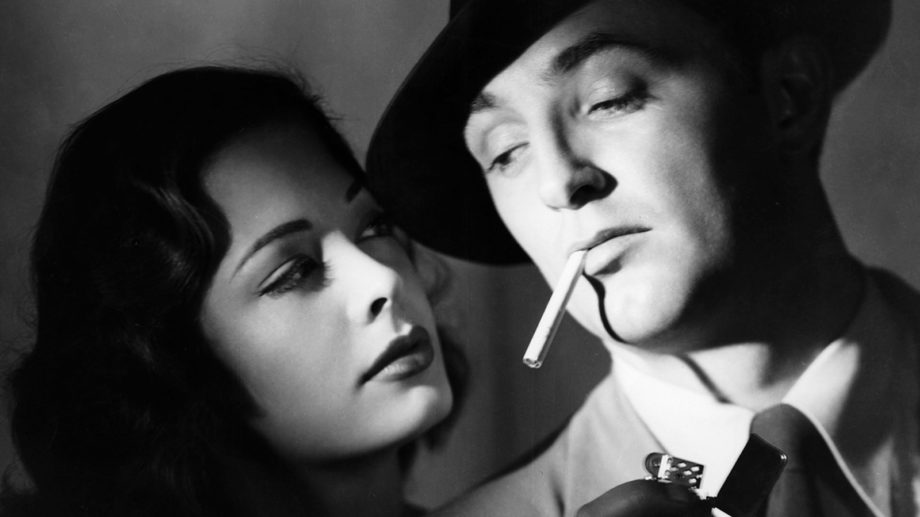A 24-film centenary tribute to the great Robert Mitchum will take place at the 55th New York Film Festival (September 28 – October 15) at the Film Society of Lincoln Center.
Hollywood has had no shortage of man’s men, but perhaps no actor advanced so complex and alluring a model as Robert Mitchum. Mitchum’s incomparable career stretched across five decades and saw him blossom from a bit player in war films and westerns in the 1940s into a bona fide star working with some of Hollywood’s most towering figures in nearly every genre imaginable. Collaborating with pantheon auteurs such as Howard Hawks, Otto Preminger, Jacques Tourneur, Vincente Minnelli, and Nicholas Ray, the handsome and endlessly charismatic Mitchum always had the aura of a man in control of both himself and his situation, yet who was nevertheless besieged—a kind of walking metaphor for modern man’s limitations amid a universe of antagonism and uncertainty. The magnetic figure he cut into the screen has endured as a paragon of timeless cool, and his spot on the Mount Rushmore of American actors is undeniable. This year marks Mitchum’s centenary, and there is no better excuse to spend time with some of the highlights of his staggeringly rich career.
Mitchum famously quipped, “Look, I have two kinds of acting. One on a horse and one off a horse.” He is best known for his noirs—Roger Ebert called him “the soul of noir”—westerns, and western/noirs, but he appeared in more than 100 films. The NYFF Retrospective showcases 24 of his finest performances and spans 50 years, from his first major role in The Story of G.I. Joe, which earned him an Academy Award nomination, to his late-career appearances in films by Martin Scorsese and Jim Jarmusch, with all but two screening on celluloid.
The 18-day New York Film Festival highlights the best in world cinema, featuring works from celebrated filmmakers as well as fresh new talent. The NYFF55 retrospective is co-programmed by Kent Jones and Dan Sullivan, FSLC Assistant Programmer. The selection committee, chaired by Jones, also includes Dennis Lim, FSLC Director of Programming; Florence Almozini, FSLC Associate Director of Programming; and Amy Taubin, Contributing Editor, Film Comment and Artforum.
Earlier this summer, NYFF announced Richard Linklater’s Last Flag Flying as Opening Night and Todd Haynes’s Wonderstruck as the Centerpiece selection.
Tickets for the 55th New York Film Festival will go on sale September 10. VIP passes and packages are on sale now and offer one of the earliest opportunities to purchase tickets and secure seats at some of the festival’s biggest events, including the just-announced Centerpiece.
Acknowledgments: Academy Film Archive; British Film Institute; UCLA Film & Television Archive; George Eastman Museum; Ned Hinkle, Brattle Theatre.
FILMS & DESCRIPTIONS
Angel Face
Otto Preminger, USA, 1953, 35mm, 91m
Robert Mitchum finds himself caught up in the machinations of a femme fatale in Preminger’s seminal noir. When ambulance driver Frank Jessup is summoned to a Beverly Hills mansion after wealthy Catherine Tremayne is evidently poisoned, he enters the orbit of her enterprising stepdaughter, Diane (Jean Simmons), who persuades Frank to quit his job and become her chauffeur—and ultimately her lover. But after sensing there may be a devious agenda behind her gentle facade, he must find a way to extricate himself from her schemes before it’s too late. Mitchum is as sympathetic and charismatic as ever in this gripping thriller to rival Preminger’s other great noirs (Laura, Whirlpool, Where the Sidewalk Ends).
Blood on the Moon
Robert Wise, USA, 1948, 35mm, 88m
Robert Wise’s synthesis of western and film noir was a breakthrough for the director and further solidified Robert Mitchum as one of Hollywood’s most intriguing leading men. Mitchum plays Jim Garry, an underemployed cowboy enlisted by an old friend (Robert Preston) to collude in a scheme to get an aging cattle owner to sell off his herd at a discount. The deadly intrigue that results from this plot leads Jim to wonder whether he’s on the right side of the conflict and to further crave the trust of the cattle owner’s daughter (Barbara Bel Geddes). Mitchum flourishes amid Wise’s assured direction of screenwriter Lillie Hayward’s foreboding, twist-laden, psychologically rich script, adapted from a novel by Luke Short.
Cape Fear
Martin Scorsese, USA, 1991, 35mm, 128m
Martin Scorsese’s staple obsessions emerge with brute force in his update of J. Lee Thompson’s 1962 Southern thriller, a gruesome tale of good versus evil where no one is entirely good and everything is dialed up with unrelenting peril. Robert De Niro is at his most terrifying as Max Cady, a ripped ex-con hell-bent on punishing his former lawyer, Sam Bowden (Nick Nolte), who buried evidence relating to Cady’s case 14 years prior. In a film marked by a twisted sense of humor, Robert Mitchum—the original Cady—appears as elderly, honorable police lieutenant Elgart, while Cady’s defense attorney is played by 1962’s Bowden, Gregory Peck.
Cape Fear
Lee Thompson, USA, 1962, 35mm, 105m
Max Cady (Robert Mitchum) is fresh out of jail following an eight-year bid for rape, and the first order of business is terrorizing lawyer Sam Bowden (Gregory Peck), who testified against him, along with Bowden’s wife (Polly Bergen) and teenage daughter (Lori Martin). J. Lee Thompson’s influential thriller, scored by Bernard Herrmann and shot by Sam Leavitt, features a performance from Mitchum that channels the menace and malice of his Harry Powell from The Night of the Hunter. Mitchum and Peck—both recast in supporting roles in Martin Scorsese’s 1991 remake—enact a mortal struggle that is enduringly gripping, harrowing and iconic.

The Lusty Men
Crossfire
Edward Dmytryk, USA, 1947, 35mm, 86m
This adaptation of writer/director-to-be Richard Brooks’s novel The Brick Foxhole, about a group of vets, led by Robert Mitchum’s Sergeant Keeley, searching postwar Washington for their amnesiac friend (George Cooper) so they can clear him of a murder charge, embodies the essence of what has come to be known as “film noir”—moody, troubled characters; nocturnal action; chiaroscuro cinematography; low-key acting spiced with bits of bravura eccentricity; and a plot so crazy that it feels like a nightmare. If Robert Ryan’s unhinged southern bigot, Gloria Grahame’s thoroughly disenchanted cocktail hostess, and Paul Kelly as her ex-(or maybe not) husband get to play the acting solos, Mitchum does a beautiful job on rhythm.
Dead Man
Jim Jarmusch, USA, 1995, 35mm, 121m
Jim Jarmusch’s hypnotic, parable-like, revisionist Western follows the spiritual rebirth of a dying 19th-century accountant (Johnny Depp) named William Blake (no relation to the poet . . . or is there?). Guiding Blake through a treacherous landscape of U.S. Marshals, cannibalistic bounty hunters, shady missionaries, and cross-dressing fur traders is a Plains Indian named Nobody (Gary Farmer), one of the most fully realized Native American characters in contemporary cinema. Dead Man doubles as a barbed reflection on America’s treatment of its indigenous people and a radical twist on the myths of the American West. Jarmusch’s metaphysical masterpiece features Robert Mitchum in one of his final roles, as a gun-toting, cigar-smoking factory owner.
El Dorado
Howard Hawks, USA, 1966, 35mm, 126m
The first of Howard Hawks’s two variations on his own Rio Bravo finds Robert Mitchum playing a hard-drinking sheriff who teams up with an old friend (hired gun John Wayne) to protect a wealthy rancher (Ed Asner) and his family from the threatening advances of another rancher’s fearsome gang. Along the way, they enlist the help of a gambler with a distinctive hat (James Caan) and an aging, Native American deputy sheriff (Arthur Hunnicutt)—but, against such great odds, will this motley crew survive? Mitchum supplies his own distinctive charm and charisma, and Hawks masterfully imbues the proceedings with both a narrative leanness and an expansive sense of character. Print courtesy of UCLA Film & Television Archive.
Farewell, My Lovely
Dick Richards, USA, 1975, 35mm, 95m
In the first half of the 1970s, Robert Mitchum reached a new peak, the end of which came with this sepulchrally nostalgic, neon-lit adaptation of Raymond Chandler’s second Philip Marlowe novel. The film has its charms—not the least of which is a cameo appearance by Jim Thompson…as Charlotte Rampling’s husband—but Mitchum (who would reprise the role of Marlowe in the truly terrible 1978 version of The Big Sleep) is the one who gives the film its secret force, as if he were confronting the end of both his leading-man identity and the world that formed him as a star with bravery and grace.
The Friends of Eddie Coyle
Peter Yates, USA, 1973, 102m
In Peter Yates’s adaptation of George V. Higgins’s novel, Robert Mitchum is Eddie, an aging, Boston-area gunrunner facing a prison bid for a job gone awry and caught in a web of deals and double-crosses while grappling with whether to give up his former associates to the feds. Fully integrating himself within a stellar ensemble cast (including a brilliant array of character actors, including Peter Boyle, Richard Jordan, and Steven Keats) and blending into Yates’s finely created working-class atmosphere, Mitchum gives one of his career-best performances here, conjuring a blend of melancholy, spiritual exhaustion, and cloaked malevolence.

The Friends of Eddie Coyle
His Kind of Woman
John Farrow, USA, 1951, 16mm, 120m
Mitchum had a good time shooting this ambling comedy thriller, playing a down-on-his-luck gambler who takes a mysterious gig that brings him to an exclusive Baja resort, where he meets up with a colorful crew of characters, including a beautiful woman (Jane Russell) and her movie star boyfriend (Vincent Price). The good time came to a close with endless reshoots of a new ending conceived by RKO studio head Howard Hughes and directed by Richard Fleischer, climaxing in a violent drunken tirade from the actor, which finished with the immortal words, “Fuck you! And fuck Howard Hughes, too!” Tirades aside, it’s one of Mitchum’s best films.
Home from the Hill
Vincente Minnelli, USA, 1960, 35mm, 150m
Vincente Minnelli’s widescreen color melodramas for MGM are all very special, and this adaptation of William Humphrey’s sprawling 1958 saga of an overpowering Texas landowner and his family (with echoes of Giant and The Big Country) is one of the finest. Mitchum—whose Captain Hunnicutt was intended for Clark Gable—got along very well with Minnelli (they’d worked together a decade earlier on Undercurrent), but less well with his younger co-star George Peppard, who asked Mitchum if he’d studied the Stanislavsky Method. “No,” said Mitchum, “but I’ve studied the Smirnoff Method.”
The Lusty Men
Nicholas Ray, USA, 1952, 35mm, 113m
“The kind of love I have for the film,” said Nicholas Ray of The Lusty Men, “is not as a filmmaker adoring a child, it’s as a part of the literature of America.” Set in the punishing, rootless world of the rodeo circuit, this is one of Ray’s very best films, and Robert Mitchum’s Jeff McCloud is its sad, busted, but still beating heart. According to Lee Server’s biography of the actor, Mitchum was so excited by his work in the film (in which he did many of his own stunts) that he went out with his director to celebrate, got drunk, appropriated a gun from an FBI agent, and fired it into a stack of dishes.
Macao
Josef von Sternberg/Nicholas Ray, USA, 1952, 35mm, 81m
Nicholas Ray was brought on to finish this atmospheric crime yarn after producer Howard Hughes forced Josef von Sternberg off the project. (Allegedly, Robert Mitchum helped write a few scenes with Ray.) But its initial director’s signature textures and tones still shine through: dresses and gloves sheathed in glitter; an Escher-like casino; a pier-set finale that recalls Sternberg’s The Docks of New York. It was, by all accounts, an unpleasant, tumultuous production. The final movie, though, is buoyant—a shimmering cinematic vacation starring Mitchum as an American runaway tasked with capturing a crime lord while also wooing a singer played by Jane Russell.
The Night of the Hunter
Charles Laughton, USA, 1955, 35mm, 92m
Robert Mitchum’s turn in the only film directed by Laughton is a towering achievement. An expressionist, southern gothic noir, The Night of the Hunter (adapted by James Agee from Davis Grubb’s novel) tracks the devious exploits of self-styled reverend and serial killer Harry Powell (Mitchum) as he gets out of jail and sets out to wed Willa Harper (Shelley Winters), the widow of his deceased cellmate, and murder her for her hidden fortune; it falls to her children to stop the madman living in their house. Mitchum is the charismatic monster lurking at the center of Laughton and Agee’s lyrical nightmare (one of only two films completed from an Agee script), and it ranks among cinema’s greatest and most chilling performances.
Out of the Past
Jacques Tourneur, USA, 1947, 35mm, 97m
Tourneur’s landmark noir boasts one of Mitchum’s most iconic roles. He is magnetic as Jeff, the low-key proprietor of a gas station in small-town California. When some ill-intentioned characters from Jeff’s shadowy past arrive on the scene looking for him, it sets off a riveting chain of events that reunites him with Kathie (Jane Greer, one of the all-time great femme fatales), the slippery girlfriend of powerful and shady Whit Sterling (Kirk Douglas). Out of the Past is singularly rich with twists, turns, and profound ideas concerning the complex relationship between the past, the present, and fate.
Pursued
Raoul Walsh, USA, 1947, 35mm, 101m
Walsh’s powerful, very dark and Freudian film noir/western hybrid—a favorite of Martin Scorsese—stars Mitchum as Jeb, the only survivor of a brutal massacre that wiped out the rest of his family when he was a boy. He is then adopted into the home of another family (led by chilly matriarch Judith Anderson), where he comes to fall in love with his foster sister (Teresa Wright). Now an adult, Jeb still yearns to untangle the messy, suppressed memories of his childhood trauma, and of the mysterious one-armed man who has haunted and tormented him throughout his life. Told in elaborate flashback, with frequent expressionistic touches, Pursued opened up new paths for the western and remains one of Mitchum’s great achievements. 35mm preservation print courtesy of the UCLA Film & Television Archive. Preservation funding provided by The Film Foundation and the AFI/NEA Film Preservation Grants Program.
River of No Return
Otto Preminger, USA, 1954, 91m
In this CinemaScope western adventure, Robert Mitchum is ex-con farmer Matt Calder, who lives with his young son in a remote riverside area. Gambler Harry (Rory Calhoun) and his fiancée Kay (Marilyn Monroe), a former saloon singer, are stranded while en route to collect on a mining claim, and Matt takes them in. When Harry tests the limits of Matt’s hospitality, he makes off with his horse and rifle, leaving Kay behind. Susceptible to the threat of hostile Indians, Matt, his son, and Kay make off down the river in Harry’s abandoned raft, but the river itself proves to be just as perilous… Monroe and Preminger had a famously rocky on-set rapport (prompting Preminger to buy out his own contract from Fox), but Mitchum’s effortless subtlety beautifully balances Monroe’s broad strokes.

The Night of the Hunter
The Story of G.I. Joe
William Wellman, USA, 1945, 35mm, 108m
Robert Mitchum’s extraordinary, Oscar-nominated performance as the stoic, exhausted, and quietly beleaguered Lieutenant Walker in this adaptation of correspondent Ernie Pyle’s dispatches from the war in Europe, made him a star. Director William Wellman, himself a WWI vet, and producer Lester Cowan closely collaborated with Pyle (played by Burgess Meredith, who was doing service in the Air Force at the time) to make a film that was true to the life of the WWII soldier—the absolute exhaustion, the endurance of terror and shock and loss, the spells of boredom, the camaraderie. The result is a film built like a ballad, unlike any other of its era. Print courtesy of the Academy Film Archive.
Till the End of Time
Edward Dmytryk, USA, 1946, 16mm, 105m
This lovely, eloquently simple film about returning WWII vets and their difficulties adjusting to the homefront was made and released by RKO to get the jump on The Best Years of Our Lives. Robert Mitchum’s Tabeshaw, who has come home with a steel plate in his head, and his pal Cliff (Guy Madison), who left as a boy and has returned as a man, spend their days looking for something they can relate to, and the action is comprised of a series of small encounters, many of which (for instance, Madison and Dorothy McGuire’s war widow flanking a vet with the shakes at a lunch counter) are quietly devastating.
Thunder Road
Arthur Ripley, USA, 1958, 35mm, 92m
This tale of moonshine runners in the hills of Tennessee and Kentucky was the most personal project of Robert Mitchum’s entire career—in addition to starring, he produced and co-wrote it. Korean War vet Lucas (Mitchum) returns home and sets about working for his family’s moonshine business, making perilous deliveries in a modified hot rod. But he soon finds himself taking heat from both the cold-blooded city gangsters who want to take control of the moonshine network and the cops who want to crack down on it. A veritable cult classic with driving scenes that still seem daring, Thunder Road is both an exhilarating ride and a richly characterized expression of Mitchum’s artistry.
Track of the Cat
William Wellman, USA, 1954, 35mm, 102m
Mitchum reunited with his Story of G.I. Joe director William Wellman (“I was very, very fond of him,” Mitchum said of Wellman, “and he tolerated me”) for a different kind of movie, based on a Walter Van Tilburg Clark novel, about a homesteading family in snow country whose livestock is being destroyed by a roaming mountain lion. Wellman and his DP William Clothier (The Man Who Shot Liberty Valance) worked out a stark visual design, keeping everything—sets, costumes, make-up, and exteriors—in black and white tones, with the exceptions of one scarlet hunting jacket and one yellow scarf. They also shot on location at Mt. Rainier, where 30-foot snowdrifts made for the most arduous and exhausting shoot of Mitchum’s career.
Undercurrent
Vincente Minnelli, USA, 1946, 35mm, 116m
A bit of an anomaly within Minnelli’s often more colorful and ebullient oeuvre, this black-and-white, paranoiac romantic thriller finds the master harnessing his consummate stylishness to spin a haunting, noirish tale. Timid Ann (Katharine Hepburn) marries the highly eligible Alan Garroway (Robert Taylor), whose wealth and good looks conceal an underlying and profound cruelty. Ann grows increasingly obsessed with learning the truth about what happened to Alan’s brother, Michael (Mitchum), who has been missing for some time… This gripping movie casts Hepburn, Taylor, and Mitchum all against type, and was one of three films that Mitchum filmed simultaneously following his breakout performance in The Story of G.I. Joe.
The Wonderful Country
Robert Parrish, USA, 1959, 35mm, 98m
This Technicolor western adapted from a novel by Tom Lea stars Robert Mitchum as an expat mercenary who fled to Mexico at age 14 after avenging his father’s murder. He’s hired by a cruel Mexican governor (Pedro Armendáriz) to carry out an arms deal that takes him to Texas, where his refusal to help hunt Apaches puts him in conflict with a U.S. Army major (Gary Merrill)—and into the orbit of the major’s unhappy wife (Julie London). Mitchum’s layered performance as a reluctantly violent man at a moral crossroads, and caught between two national identities, is the heart of Parrish’s elegiac, cerebral western, exquisitely shot by Alex Phillips and Floyd Crosby.
The Yakuza
Sydney Pollack, USA, 1974, 35mm, 112m
East meets West in the form of two iconic stars: Japanese gangster film star Ken Takakura teams with Mitchum in a thriller set in Tokyo’s treacherous criminal underworld. Mitchum delivers an alternately rough and sleepy, cynical and gentle performance as retired cop Kilmer, who returns to Japan after many years to help an old army buddy (Brian Keith) after his daughter is kidnapped by a yakuza boss. Navigating the complex codes of the yakuza ethos, he’s guided by Ken (Takakura), a former gangster and brother of Mitchum’s old flame, but betrayals and double crosses lie ahead in Paul Schrader’s first feature screenplay, co-written with his brother Leonard and Robert Towne. Even in his late fifties, Mitchum proves he’s fully capable of handling complex action choreography. Print courtesy of the Academy Film Archive.




